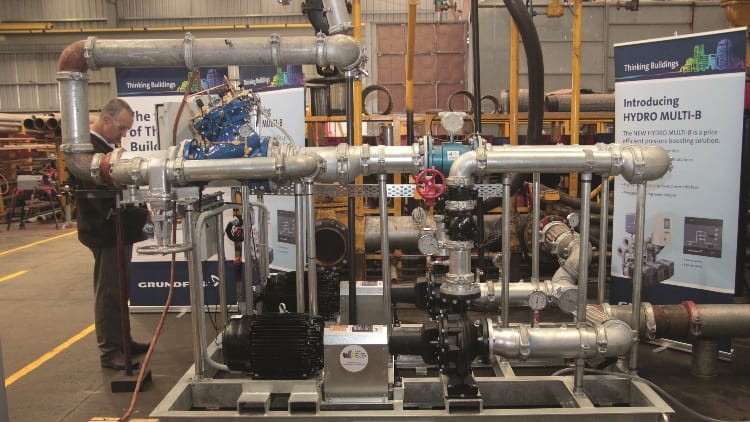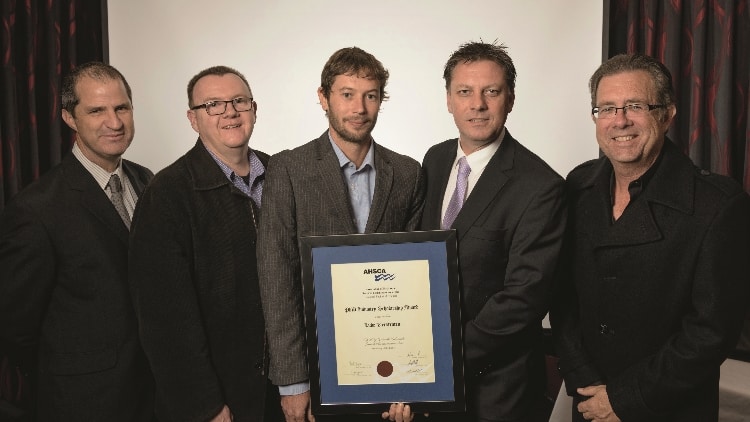An Educated Approach to Research
The Association of Hydraulic Services Consultants Australia has teamed up with the University of the Sunshine Coast to undertake research that will change the way industry approaches roof drainage systems. Plumbing connection will continue to report on the project along the way.
It was revealed in February that the Association of Hydraulic Services Consultants Australia (AHSCA) and the University of the Sunshine Coast (USC) had signed an agreement to undertake cutting-edge research to investigate, quantify and accurately predict the hydraulic behaviour of roof water in box gutters and downpipes of large buildings.
Both the AHSCA and USC recognised that the current standard referenced in the Building Code of Australia, (AS/NZS 3500.3) has significant limitations that have hampered the broader construction industry for some time.

The specific components of roof drainage systems to be investigated are internal box gutters, overflows and downpipes. The primary focus of the research will be the design restrictions relating to allowable maximum downpipe sizes and the maximum flow rates for box gutters, overflows and downpipes.
Some of the current restrictions include:
– Flow rates for box gutters are limited to 16 l/s.
– Flow rates for downpipes are limited to 16 l/s.
– Downpipe sizes are limited to 150 mm diameter.
– Flow rate for sumps and overflow devices are limited to 16 l/s.
Recommended overflow configurations are considered to be restrictive and do not reflect industry practice.
These restrictions severely limit the design options that can be considered when designing roof drainage systems for large buildings. As part of its responsibility and commitment to its members, the AHSCA commissioned a comprehensive research study to develop accurate performance and design guidelines for roof drainage systems.
An integral part of the research project included the development of a full-scale box gutter and downpipe test rig at USC. The rig stands at over 25m in length and 7m high and includes a fully-adjustable box gutter system with the capacity for multiple outlets and downpipes. By developing such a large test rig, it is possible for realistic flow conditions of large buildings to be accurately established and simulated.
The design of the rig ensures complete flexibility in the testing parameters and also allows for prototype testing of rainwater products under authentic hydraulic conditions.
It is envisaged that alteration of these design restrictions may substantially reduce the cost of roof drainage systems and significantly minimise the risk of property damage caused by water ingress through system failure.
If roof drainage systems are in fact capable of operating more effectively and with greater capacities than the current design standards allow, this research could lead to significant reductions in unsustainable building practices and construction costs.
RESEARCH
More experimental research is required to accurately evaluate the capacity of conventional roof drainage systems and to investigate how it might change in the future due to expected increases in rainfall intensities resulting from climate change. This is where the vision of Mark Alexander of the AHSCA became integral to the research project taking flight.
Sure, the AHSCA could have gone about the research themselves; however, it was important to them, and their members that project outcomes were both scientifically robust and have practical application. Effectively, the research aims to better the entire industry’s knowledge in the area of roof drainage. As a result of this, its members raised some $300,000 to aid the project.
So, you might be wondering who has the role of conducting all of this research.
Well, as part of the collaboration between the AHSCA and USC, an opening for a PhD scholarship has been created.

The research project includes detailed desktop studies and full-scale physical modelling, including comprehensive analysis and reporting of research results, writing interim industry progress reports, liaison with industry representatives when required, and contribution to the design processes required for new product development.
The project also involves a significant amount of hands-on construction and fabrication activities such as optimising gutter width sizes, gutter slopes, connecting and disconnecting downpipes, installing gutter outlets in the base of gutters, connection and operation of flow monitoring equipment and devices and similar manual and physically-demanding activities.
The testing rig will be designed to accommodate the array of gutter, downpipe and overflow configurations to be investigated as part of this research study. The research will focus on identifying the system configurations with the greatest practical applicability.
As you can see, it’s certainly not a straight forward project and one best suited to someone with a technical trade background or experience in the construction industry. For a lot of students, it might prove a mountain too high to climb. Thankfully a suitable candidate rose to the occasion. Luke Verstraten decided to further his education at the University of the Sunshine Coast after successfully running his own irrigation and landscaping business for over 10 years.
“I graduated from my Bachelor in Environmental Science Degree in 2011 and I received a university commendation for my academic achievements. By the time I finished my undergraduate degree I knew that I had developed a passion for undertaking research projects that are practical and relevant with benefits to industry and society,” Luke says.
Since graduating, Luke has worked on several national and international collaborative research projects with the Department of Agriculture, Forestry and Fisheries (Federal and Qld), The Indian Ocean Commission, University of the Sunshine Coast, Griffith University, La Trobe University and the University of Queensland. While working on a national research programme 3-year investigation into Soil Carbon he was able to further his studies by completing his first class Honours degree.
“I was particularly interested when I first heard about the AHSCA project as I saw it as having the ability to expand the current knowledge of roof drainage systems through realistic physical testing on a scale that has not been attempted before.
“I was therefore very keen on being involved with this cutting-edge research project and I immediately applied for the USC/AHSCA PhD scholarship. Fortunately I was successful with my application and I am pleased to be working with my PhD supervisors, Dr Terry Lucke and Dr Helen Fairweather, who bring to the project a wealth of experience and knowledge.
“Day-to-day activities will vary throughout the project. Currently the construction and design of the testing rig and reviewing of relevant literature are the predominant activities. This is expected to be completed within the next two months,” Luke says.
“Once the rig is constructed the experimental phase will begin and we will start by testing a number of gutter, sumps, overflow and down pipe configurations at flow rates of up to 100L/s. To my knowledge this is the first project globally to investigate conventional gutter systems on this scale at these flow rates and much of this capacity is owed to the one off pump designed and built for the project by Grundfos.
“As data is collected we can begin to analyse the performance boundaries of roof drainage and develop models to aid the hydraulic industry in making accurate and informed performance based design choices.”

GRUNDFOS PUMPS
The research could not be achieved without high-performance pumps and the team at BKB Grundfos were both willing and able to deliver a pump system that met the requirements of both the AHSCA and the team at USC.
“What we have developed is a dual pump system which sees both pumps able to simulate up to 50L/s as the research team would like to simulate rainfall collection from 5L/s-100L/s. The main reason for having two pumps is that the flow range of 5-100L/s is too large for one pump to handle. We decided it was better to use two pumps rather than run one horribly inefficiently or overloading it potentially,” Hydraulic Account Manager Grundfos BKB Nick Russ says.
“We’re not expecting the tank to be empty, particularly if the discharge is going back into the tank but there is a float switch there to disable the pumps should they ever be empty and risk running the pumps dry. We have separate suction lines for each pump too.
BKB kindly donated the pumps to the AHSCA, for which their members and the industry as a whole are incredibly grateful.
“We pushed hard and got the majority of the pumps constructed in a week. Needless to say a lot of overtime went in to make it happen but once we have a goal in mind, we can achieve anything here,” Nick says.
“As we are members of the AHSCA ourselves, we felt as though it was good to give something back. At the end of the day, we are doing this so that the industry knows what is required as part of an efficient and satisfactory roof drainage system. They will get something out of it, and we hope that we will too.”
